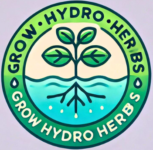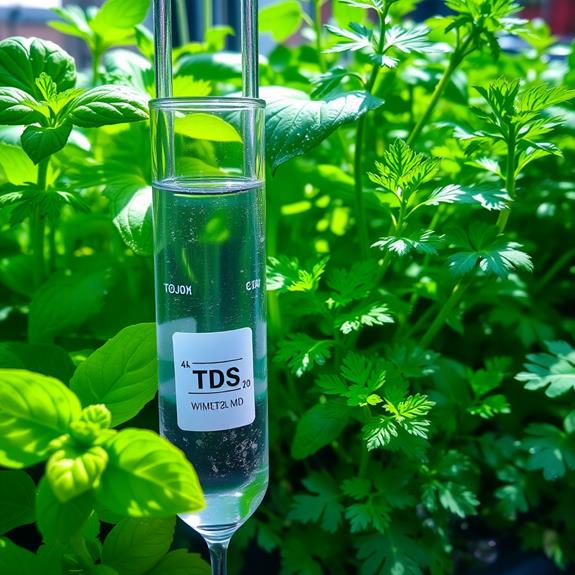Manage pH for your Hydroponic Garden
If you manage pH in hydroponics for your herb garden, it can mean the difference between success and failure. It’s not just a small detail; it can really affect how well your plants grow and stay healthy.
To keep your plants happy, aim for a pH level between 5.5 and 6.5. This range helps your plants absorb nutrients better.
Make sure to check the pH regularly. If you know how to change the pH levels, you can avoid problems like nutrient lockout.
But what should you do if you run into common pH issues? Knowing about the tools you can use will help a lot!
Taking care of pH in your garden makes a big difference in your plants’ success.
GrowHydroHerbs TLDR
- Maintain Optimal pH: Keep your hydroponic system’s pH between 5.5 and 6.5 for most plants to ensure optimal nutrient absorption.
- Regular Monitoring: Check pH levels daily to prevent imbalances that can lead to nutrient deficiencies or plant stress.
- Adjustments Matter: Use pH-up or pH-down solutions, natural methods, or automated systems to maintain the ideal pH range.
- Plant-Specific Needs: Different plants may have slightly different pH preferences; adjust accordingly to maximize growth and health.
- Prevent Nutrient Lockout: Proper pH management helps avoid nutrient lockout, ensuring your plants receive the nutrients they need to thrive.
Understanding pH: What It Is and Why It Matters
pH is a measure of how acidic or basic (alkaline) a substance is. It’s represented by a number on a scale from 0 to 14. A pH of about 7 is neutral, meaning it’s neither acidic nor basic. If the pH is below 7, the substance is acidic. If the pH is above 7, it’s basic or alkaline.
In a nutshell. Life exists in a narrow pH range. That range is different for different living creatures. Here we look at plants, specifically herbs. But even there, the range may even vary slightly between varieties of the same herb.
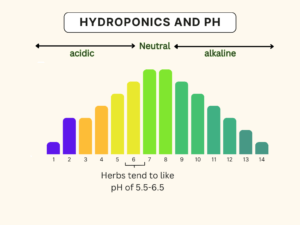
In hydroponics, pH is important because it affects how well plants can absorb nutrients from the water. If the pH is too high or too low, your plants might not get the nutrients they need to grow properly. For example, if the pH is too high, plants might struggle to absorb iron, leading to yellow leaves. If it’s too low, they might miss out on calcium or magnesium, causing other growth problems.
By keeping the pH in the right range—usually between 5.5 and 6.5—you help ensure that your plants can access all the nutrients they need. Regularly checking and adjusting the pH is key to maintaining a healthy hydroponic garden. Understanding pH helps you better care for your plants and avoid common issues like nutrient lockout, where plants can’t absorb nutrients effectively due to improper pH levels.
Why you need to Manage Ph in Hydroponics
In hydroponics, pH is really important. It affects how well plants can take in nutrients.
If the pH level is too high or too low, it can hurt your plants. You might see problems like nutrient shortages and slow growth.
By keeping the pH in the right range, you help your plants thrive. This means they can grow strong and reach their full potential.
Nutrient Availability
Keeping the right pH level in your hydroponic garden is super important for healthy plants. The pH level affects how well your plants can take in nutrients.
The ideal pH range for most plants is between 5.5 and 6.5. If your pH goes too high or too low, your plants might struggle to absorb the nutrients they need. This can lead to something called nutrient lockout.
Here’s how different pH levels can affect your plants:
| pH Level | Nutrient Impact |
|---|---|
| Above 6.5 | Plants may lack iron, causing yellow leaves. |
| Below 5.0 | Plants may lack magnesium and calcium. |
| 5.5 – 6.5 | This is the sweet spot for nutrients! |
| Regular Checks | Helps avoid nutrient lockout. |
It’s really important to check and adjust your pH levels regularly. Changes can happen because of the nutrient solution or how much your plants are using. If you don’t keep an eye on this, your plants might stop growing well or develop issues that you could have easily prevented.
Also, remember that different plants have different pH needs. For example, blueberries like a pH of 4.0 to 5.0. By monitoring the pH levels closely, you’ll help your plants get the nutrients they need and grow strong in your hydroponic setup.
Plant Health Impact
The pH level in hydroponics is really important. It affects how healthy plants are and how well they take in nutrients.
To help plants grow best, keep the pH between 5.5 and 6.5. Different hydroponic herbs need different nutrients. If you don’t check the pH levels, plants might get locked out from nutrients. This can lead to problems like yellowing leaves from iron deficiency or issues with magnesium and calcium if the pH is too low.
Also, when you choose the right herbs, it helps to pick ones that do well in your pH range.
Make sure to check your pH levels regularly, at least twice a day. This helps prevent imbalances in nutrients. Different crops like different pH levels, so it’s a good idea to group plants with similar needs.
Using automatic pH adjusters can really help. They reduce mistakes and keep everything balanced.
Ideal Ph Ranges for Herbs
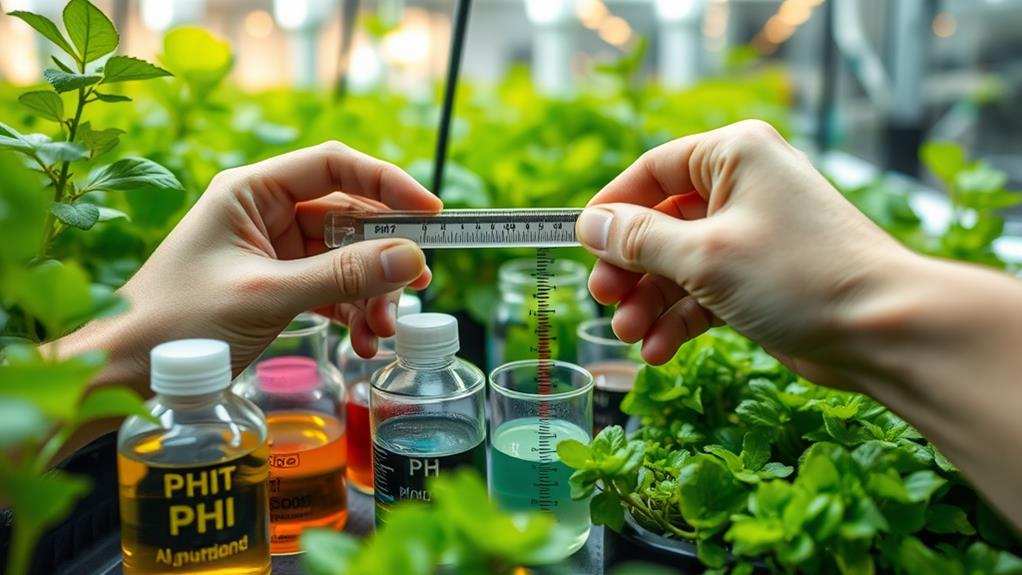
When you grow herbs in water without soil, it’s important to know the right pH levels to help them grow strong and healthy.
Most herbs like their pH to be between 6.0 and 7.0.
However, some herbs, like basil, like it a little more acidic.
Understanding these differences can help you adjust the pH levels.
This way, your herbs can thrive and reach their full potential!
Optimal Ph Levels
Herbs do best when grown in certain pH levels. For hydroponic gardeners, knowing these levels is super important.
Most herbs like a pH range between 5.5 and 6.5. This range helps them take in nutrients, which keeps them healthy.
For example, basil likes a slightly acidic pH of about 5.5. On the other hand, mint prefers a more alkaline range, around 6.0 to 7.0.
Light is also really important for photosynthesis in hydroponic systems. Keeping the right pH level works hand-in-hand with the light your herbs need.
Cilantro is another herb that grows well at a pH of 6.0 to 7.0, which helps it absorb nutrients effectively.
Oregano and thyme are a bit more flexible. They can handle a pH range of 6.0 to 7.0, so they can adjust to changes in your nutrient solution.
It’s crucial to check your pH levels regularly. If the levels go too high or low, it could cause nutrient lockout. This means your plants won’t get the nutrients they need, which can slow down their growth and reduce your harvest.
By keeping an eye on your nutrient solution’s pH and making changes when needed, you can help your herbs grow to their full potential.
Balancing pH levels not only keeps plants healthy but also boosts your hydroponic garden’s productivity!
Common Herb Variations
If you want your hydroponic garden to thrive, it’s important to know the right pH levels for the herbs you’re growing. Each type of herb likes a different pH level, and adjusting these levels can help them absorb nutrients better and stay healthy.
Here’s a simple guide to the best pH ranges for some popular herbs:
- Basil and Cilantro: They grow best in a pH range of 6.0 to 7.0.
- Mint: This herb likes a bit more alkalinity, so aim for a pH between 6.0 and 7.5.
- Parsley: It does well in a pH range of 6.0 to 7.0, which makes it easy to grow alongside other herbs.
- Thyme and Oregano: These herbs are flexible and can handle a pH range of 6.0 to 8.0.
- Dill: This herb prefers a slightly acidic to neutral pH, between 5.5 and 6.5.
Impact on Growth
Maintaining the right pH levels is really important for growing hydroponic herbs. Most herbs grow best in a pH range of 6.0 to 7.0. This helps them take in nutrients and grow healthy.
For example, basil likes a slightly acidic environment, with a pH of 5.5 to 6.5. Rosemary, on the other hand, prefers a more alkaline range of 6.0 to 7.0. Mint is flexible and can grow well in a pH range of 6.0 to 7.0, making it perfect for different hydroponic setups.
It’s also helpful to know the specific needs of each herb. This can help you manage pH levels better and create the best conditions for them to grow strong.
Cilantro thrives in a pH range of 6.0 to 7.5, enjoying slightly alkaline conditions.
If you regularly check and adjust the pH for each type of herb, you can boost their growth rates and overall harvest.
If pH levels go too high or too low, the herbs mightn’t absorb nutrients properly. This can slow down their growth and lower your yield.
Methods to Adjust Ph Levels

To keep your hydroponic garden healthy, it’s important to adjust the pH levels properly.
There are different ways to do this, such as using chemical solutions, natural pH adjusters, or automated control systems.
Each method has its own advantages.
So, it’s important to find the one that works best for your garden setup.
Chemical Solutions Overview
Adjusting the pH levels in your hydroponic system is very important. It helps keep your plants healthy and improves their growth. The right pH range for plants is between 5.5 and 6.5.
Sometimes, you’ll need to use chemical solutions to change the pH levels. Here are some easy ways to do that:
- Phosphoric acid: If you want to lower the pH, use 0.1 mL for every gallon of water. This is especially helpful in hard water.
- Potassium hydroxide: To raise the pH, mix 1 tablespoon for every 3 gallons of nutrient solution.
- Baking soda: You can also use baking soda to increase pH. But keep in mind, it’s not the best choice for long-lasting changes.
- White vinegar: This can lower pH temporarily. Use 1 tablespoon for every 4 gallons. However, it’s not great for long-term control.
- Regular testing: Make sure to check your pH levels at least twice a day. This helps prevent sudden changes that can stress your plants.
Natural Ph Adjusters
Finding the right pH balance in your hydroponic garden is super important for your plants’ health and growth. If your pH levels are too high or too low, you can use natural pH adjusters to fix them.
For example, if you need to lower the pH, white vinegar works well. Just add 1 tablespoon for every 4 gallons of water. Keep in mind that this fix only lasts for a short time.
If you have hard water, phosphoric acid is a good choice. You can use 0.1 mL per gallon to aim for a pH of around 6.8.
Also, if your pH levels are too high, aspirin can help! Taking 2 tablets per gallon can lower the pH from 8.0 to about 6.0.
For larger systems, you can use baking soda to raise the pH. Just add 1 tablespoon for every 3 gallons of water.
These natural pH adjusters are useful, but remember to check your pH regularly. Make sure it stays in the best range for your plants to grow strong and healthy!
Automated Control Systems
In hydroponic gardening, automated control systems are super important for keeping the right pH levels for your plants. These systems use sensors to check pH levels all the time. This helps keep the pH between 5.5 and 6.5, which is best for your plants to take in nutrients.
But that’s not all! Paying attention to light intensity and measurement can also help your plants grow better when you have stable pH levels. With automated pH control systems, you can make adjustments easily without needing to test everything manually.
Here are some cool benefits of these systems:
- They can automatically add pH adjusters like phosphoric acid or potassium hydroxide based on real-time data.
- You’ll get alerts on your mobile app, so you can make quick changes even when you’re not in the garden.
- You’ll save time and cut down on labor costs because you won’t need to test pH manually as often.
- It’s a good idea to calibrate your automated pH meters regularly to make sure they’re accurate—aim for checking at least once a month.
- With consistent pH management, your plants will be healthier and you’ll get bigger harvests.
Investing in these systems makes gardening easier and helps your plants thrive in a balanced environment.
When you use automated control systems, you set your hydroponic garden up for success. This way, you can focus more on what you love—growing your plants!
Common Ph Issues and Solutions
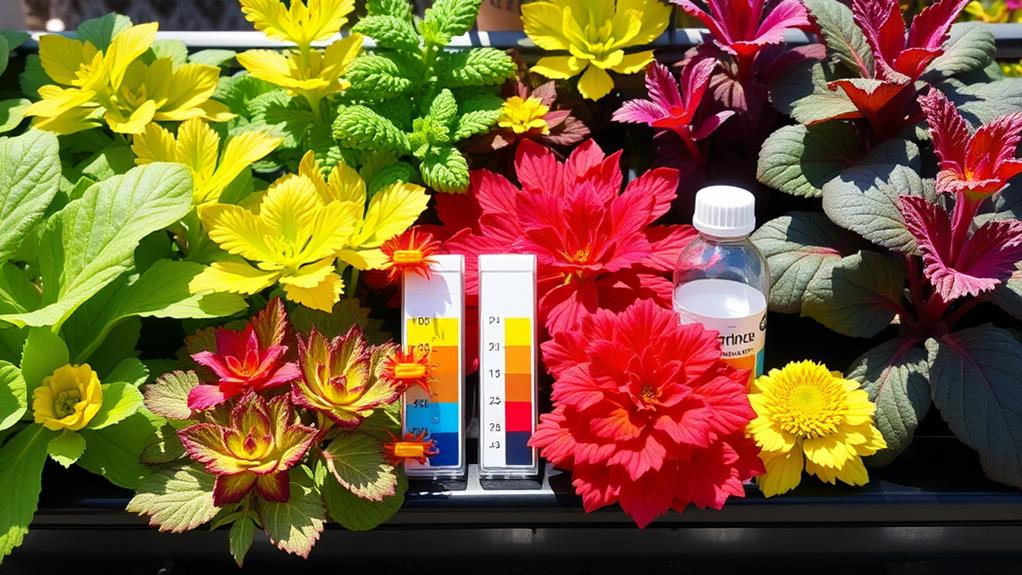
In hydroponic gardening, keeping the right pH level is very important. If the pH is off, it can cause problems like nutrient lockout. This means your plants won’t get the food they need to grow well.
There are a few reasons why pH levels can change quickly. For example, the amount of nutrients you use and how much water evaporates can affect pH.
The good news is that you can fix these problems!
If your pH is too low, you can use phosphoric acid to bring it down.
If your pH is too high, potassium hydroxide can help raise it.
Ph Imbalance Causes
pH imbalances can be tricky for hydroponic gardeners. They can cause big problems for your plants. To keep your plants healthy, it’s important to know what can change pH levels.
Several factors can affect how plants take up nutrients, which can then change the pH of your nutrient solution. Here are some common reasons why pH levels might go off track:
- When plants take in nutrients, they can change the amount of ions in the solution, which shifts the pH.
- Algae can also mess with pH levels. During the day, algae uses up CO2, but at night, they release acids that can lower pH.
- Using inorganic materials like gravel can unexpectedly raise pH levels because of their chemical nature.
- If your plant roots are sick, they might release organic acids, which can lower pH significantly and stress your plants.
- If you don’t regularly test and adjust the pH, you might end up with nutrient lockout, making it hard for your plants to get the nutrients they need.
To avoid these pH problems, make sure to check your nutrient solutions often. Be ready to adjust the pH when needed. By staying alert, you can spot issues early and help your hydroponic garden flourish.
Remember, keeping pH levels steady is crucial for preventing diseases and helping your plants grow strong.
Also, by learning how the light spectrum affects plant growth, you can improve your pH balance strategy even more!
Corrective Measures Available
Maintaining the right pH balance is super important for a healthy hydroponic garden. When the pH is off, plants can struggle to get the nutrients they need. Here are some easy ways to fix common pH problems.
If your pH is too high, you can add phosphoric acid. A good rule is to use about 0.1 mL for every gallon of water, especially if you have hard water. If your pH is too low, potassium hydroxide can help raise it. Just remember to make changes slowly so you don’t stress your plants.
It’s also helpful to know about light spectrum optimization. This can ensure your plants get the right type of light for growth, which helps with nutrient absorption and keeps pH stable.
Regularly checking pH levels is key. Use a digital pH meter at least twice a day. This way, you can quickly spot any pH issues in your nutrient solution. Catching problems early helps prevent nutrient lockout.
For larger hydroponic setups, think about using automatic pH adjusters. These handy devices make it easier to keep pH levels steady without needing to adjust them manually all the time.
Tools for Monitoring Ph
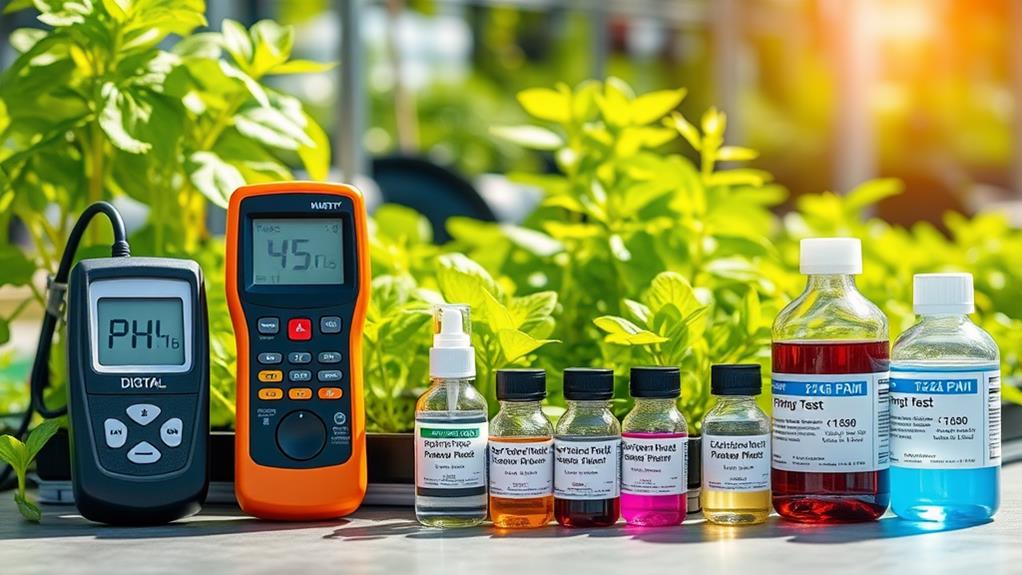
To keep your hydroponic garden healthy, you need good tools to check pH levels.
There are a few options you can choose from:
- Digital pH Meters: These give you quick and accurate readings.
- Test Strips: These are simple to use and can show you the pH level by changing color.
- Automatic Controllers: These can monitor and adjust pH levels for you.
Each tool has its own benefits.
Ph Meters Overview
In a hydroponic garden, it’s super important to have the right tools to check pH levels. pH meters help you measure how acidic or alkaline your nutrient solutions are. Most plants like their pH level to be between 5.5 and 6.5. Checking this regularly can help prevent problems and keep your plants healthy.
Here are some options to think about when choosing a pH meter:
- Digital pH meters: These give you precise readings and are more reliable than pH paper.
- Calibration: Always calibrate your meter using buffer solutions to ensure accurate measurements.
- Testing kits: You can find these at different price points. For example, an AC Infinity Hydroponic Meter Pro Kit costs about $150, while a Mini Lab Grade pH Probe is available for $89.99. This way, there’s something for every budget.
- Maintenance: It’s important to recalibrate your meter regularly to get consistent readings.
- Automatic pH controllers: These advanced tools can adjust pH levels automatically, making your job easier.
Using the right pH meter can really boost your hydroponic garden’s performance. Healthy plants and bigger yields are just a good pH level away.
Don’t forget how important it’s to manage pH accurately!
Test Strips Benefits
Test strips are a handy tool for checking pH levels in your hydroponic garden.
Even though digital pH meters are more precise, test strips are easier to use and cheaper. They make it simple for anyone, whether you’re a beginner or a pro, to measure and manage pH levels.
With test strips, you just compare the colors on the strip to a color chart. This gives you a quick way to see if your pH is in the right range, without needing fancy equipment.
While test strips aren’t as accurate as digital meters, they can still pick up on big changes in pH. This is important since keeping the pH between 5.5 and 6.5 is crucial for your plants’ health.
Even small changes in pH can affect how well your plants grow and how nutrients are absorbed.
Using test strips regularly helps you notice trends in pH over time. This way, you can learn how different factors influence your hydroponic setup.
Automatic Controllers Advantages
Automatic pH controllers are game changers for anyone growing plants in hydroponic gardens. They make it super easy to keep pH levels just right. With these handy tools, you can watch your pH levels in real time. This means you can make sure they stay between 5.5 and 6.5, which is the perfect range for plant health.
Keeping pH levels steady helps plants take in nutrients better. It also prevents problems that can stop plants from getting the nutrients they need. This can lead to healthier plants and bigger harvests!
Here are some great benefits of using automatic pH controllers:
- Less manual work: You won’t have to spend as much time checking pH levels all the time.
- Better accuracy: These tools help keep pH levels correct, so you make fewer mistakes.
- Remote access: You can check and change pH levels using your smartphone, no matter where you are.
- Long-term savings: Spending money on these controllers can help you use resources better and keep your plants healthy.
- Peace of mind: Since these controllers adjust automatically, you can focus on other gardening tasks.
In short, automatic pH controllers make gardening easier and more effective!
Why Manage pH in Hydroponics?
It is really important to manage pH in hydroponics to keep your plants healthy. It helps them take in nutrients the right way.
To give your plants the best chance, try to keep the pH levels between 5.5 and 6.5. This is the sweet spot for plant growth.
Make sure to check the pH regularly using the right tools. This way, you can spot any problems early on.
If you find that the pH is off, don’t hesitate to make adjustments.
With a little attention to pH, you can enjoy vibrant and thriving plants.
Remember, taking care of the pH can lead to a bountiful harvest!
Questions? We Have Answers.
Get answers to a list of the most Frequently Asked Questions.
